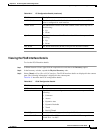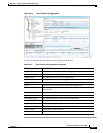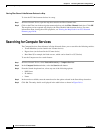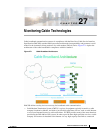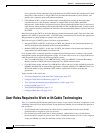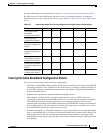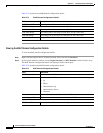
27-2
Cisco Prime Network 4.0 User Guide
OL-29343-01
Chapter 27 Monitoring Cable Technologies
User Roles Required to Work with Cable Technologies
service provider. On the subscriber side of the headend, the CMTS enables the communication with
subscribers' cable modems. A single CMTS can accommodate thousands of cable modems, and
provides the connection point to the Internet backbone.
• Cable Modem (CM) is a type of network bridge and modem that provides bi-directional data
communication via radio frequency channels on a hybrid fiber-coaxial (HFC) and RFoG
infrastructure. Cable modems are primarily used to deliver broadband Internet access in the form of
cable Internet, taking advantage of the high bandwidth of a HFC and RFoG network. Usually located
at the customer premises, terminates the cable line, and modulates/demodulates signals to and from
the CMTS.
Data flowing from the CMTS to the Cable Modem is deemed downstream traffic. Data from the Cable
Modem to the CMTS is upstream traffic. A DOCSIS binary configuration file provides the appropriate
ISP parameters for cable modems to connect to the network.
There are two types of CMTS systems, which are explained below:
• Integrated CMTS (I-CMTS)—In this type of CMTS, the contents of the downstream channel are
directly modulated and transmitted by the Downstream RF Port.
• Modular CMTS (M-CMTS)—In this type of CMTS, the contents of the downstream channel are
encapsulated into a DEPI tunnel for transmission.
Cisco Systems offers a complete portfolio of standards-based cable products, solutions, and network
management systems that enable integration of data, voice, and video services on a single multiservice
cable IP network. Cisco offers the following CMTS systems:
• The Cisco uBR7100 Series, Cisco uBR7200 Series, and Cisco uBR10012 Universal Broadband
Routers combine a CMTS with a fully integrated Cisco IOS® Software router.
• Cisco RF Switch works with the Cisco uBR10012 to offer a new level of high availability suited for
DOCSIS, EuroDOCSIS, or PacketCable applications. Together with the Cisco uBR10012, the Cisco
RF Switch enables a fully redundant CMTS with no single point of failure, including the
upconverter.
Topics covered in this section are:
• User Roles Required to Work with Cable Technologies, page 27-2
• Configure Cable Ports and Interfaces, page 27-11
• View Upstream and Downstream Configuration for Cable, page 27-12
• Configure QAM, page 27-12
• View QAM Configurations, page 27-13
• Configure DEPI and L2TP, page 27-14
User Roles Required to Work with Cable Technologies
Table 27-1 identifies the GUI default permission or device scope security level that is required to work
with Prime Network Vision. Prime Network Vision determines whether you are authorized to perform a
task as follows:
• For GUI-based tasks (tasks that do not affect devices), authorization is based on the default
permission that is assigned to your user account.
• For element-based tasks (tasks that do affect elements), authorization is based on the default
permission that is assigned to your account. That is, whether the element is in one of your assigned
scopes and whether you meet the minimum security level for that scope.




